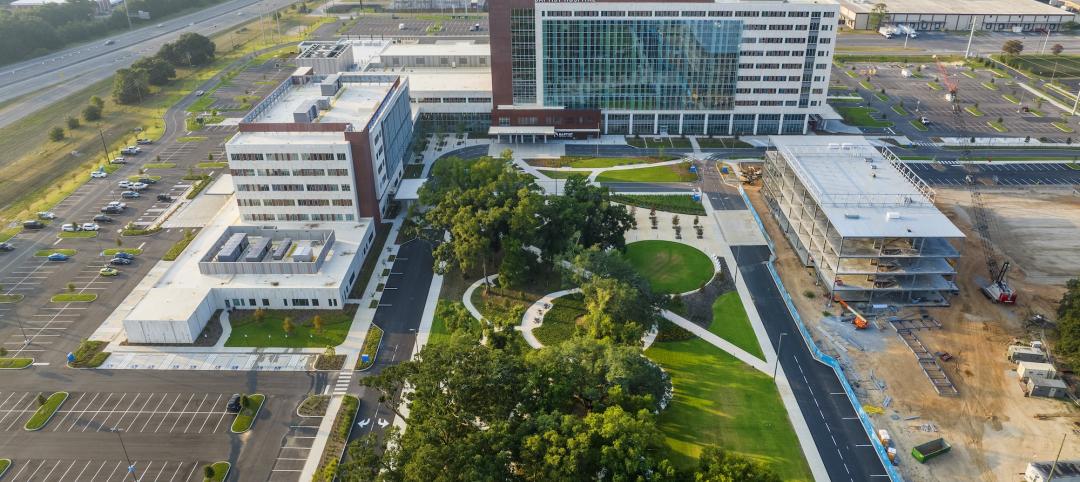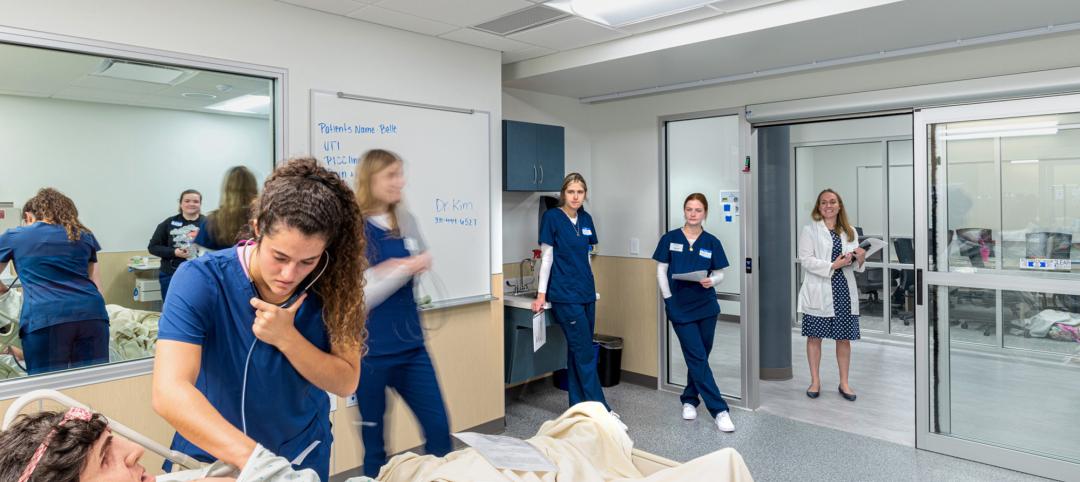The American Institute of Architects (AIA) Academy of Architecture for Health (AAH) named five projects winners of its 2019 Healthcare Design Awards.
The awards recognize cutting-edge designs that help solve aesthetic, civic, urban and social problems while also being functional and sustainable. Recipients can include healthcare building design, healthcare planning, and healthcare design-oriented research.
This year’s projects were awarded by a seven-member jury:
• Marlon Blackwell, FAIA (Chair), Marlon Blackwell Architects, Fayetteville, Arkansas
• Vincent Della Donna, AIA, ACHA, Jackson, New Jersey
• Brian Uyesugi, NBBJ, Seattle, WA
• Sunil Shah, Kaiser Permanente, Oakland, California
• Jim Henry, AIA, CallisonRTKL, Dallas, TX
• Jocelyn Stroupe, CannonDesign, Chicago, IL
• James Childress, FAIA, Centerbrook Architects, Centerbrook, Connecticut
The 2019 Healthcare Design Award winners are (project descriptions and images courtesy AIA):
Category A - Built: Less than $25 million (construction cost)
The GHESKIO Tuberculosis Hospital, Port-au-Prince, Haiti | MASS Design Group
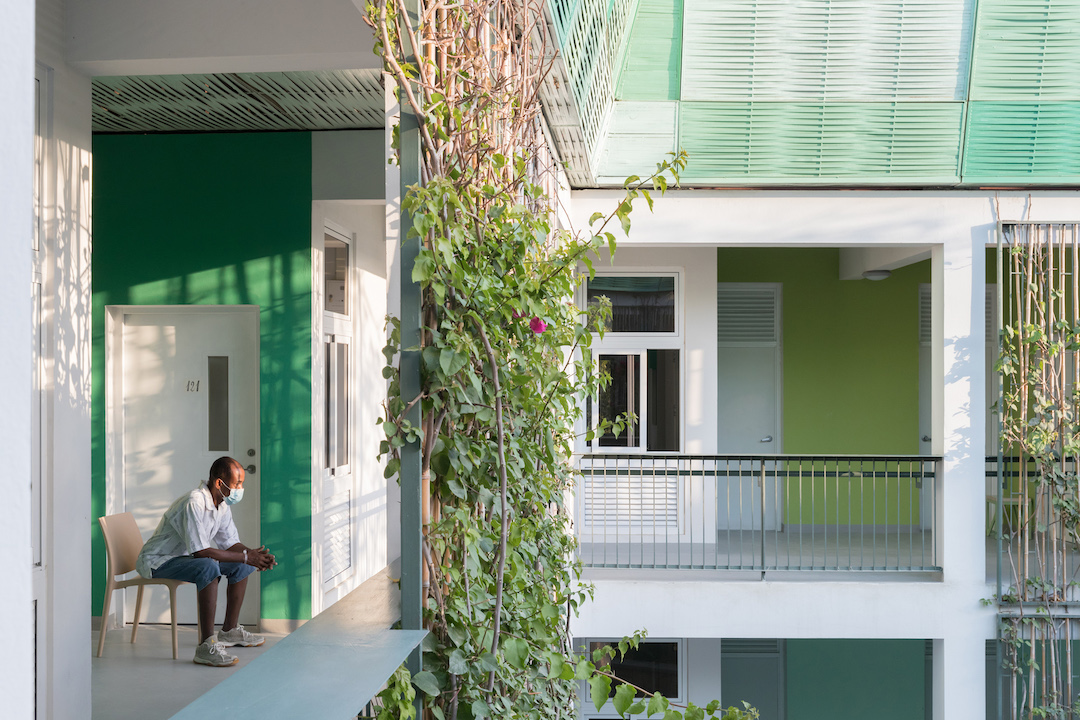 Photo: Iwan Baan, www.iwan.com, courtesy AIA
Photo: Iwan Baan, www.iwan.com, courtesy AIA
The earthquake that hit Port-au-Prince in 2010 exacerbated Haiti’s already high prevalence of tuberculosis by destroying the country’s health infrastructure and interrupting patient treatments. This precipitated an outbreak of Multi-Drug Resistant Tuberculosis (MDR-TB), a highly contagious disease that requires treatment lasting up to 24 months. Patients remain infectious for the first 2-6 months of their treatment regimen, during which time they need to be hospitalized in isolation to prevent the spread of the disease.
Both infection control and patient trauma—from extended seclusion and because of the severe side effects of medication (which can include blindness, deafness, and emotional instability)—were driving factors in the design of the Tuberculosis Hospital for Les Centres GHESKIO. The new GHESKIO Tuberculosis Hospital replaced the previously destroyed facility at Signeau, providing TB patients an effective and dignified place to stay for the duration of their long-term treatment. Simple but effective methods of passive ventilation and infection control were used to reduce in-hospital transmission of TB in this high-risk population, as well as reduce energy costs for the facility.
 Photo: Iwan Baan, www.iwan.com, courtesy AIA
Photo: Iwan Baan, www.iwan.com, courtesy AIA
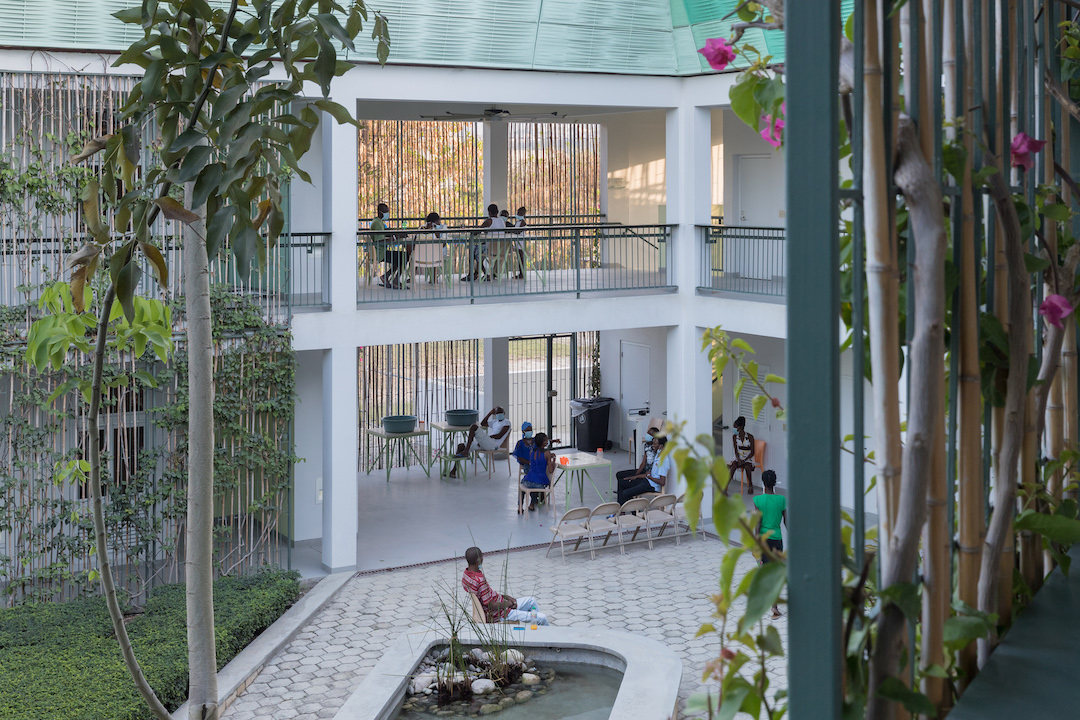 Photo: Iwan Baan, www.iwan.com, courtesy AIA
Photo: Iwan Baan, www.iwan.com, courtesy AIA
Project attributes
Construction cost or anticipated construction cost: $2 million
Building area or anticipated building area: 14,000 sq ft
Construction start date or anticipated construction start date: June 2012
Substantial completion date or anticipated substantial completion date: March 2015
Project team
Construction Manager: GBS Group
Engineer -Civil: Fall Creek Engineering
Engineer - M/E: Berelec
Engineer - Structural: CBI Consulting
General Contractor: Chantiers d’Haiti
Landscape Architect: MASS Design Group
Landscape Consultants: Jardins & Accessoires
Westlake Dermatology Concrete and Glass Pavilion, Marble Falls, Texas | Matt Fajkus Architecture
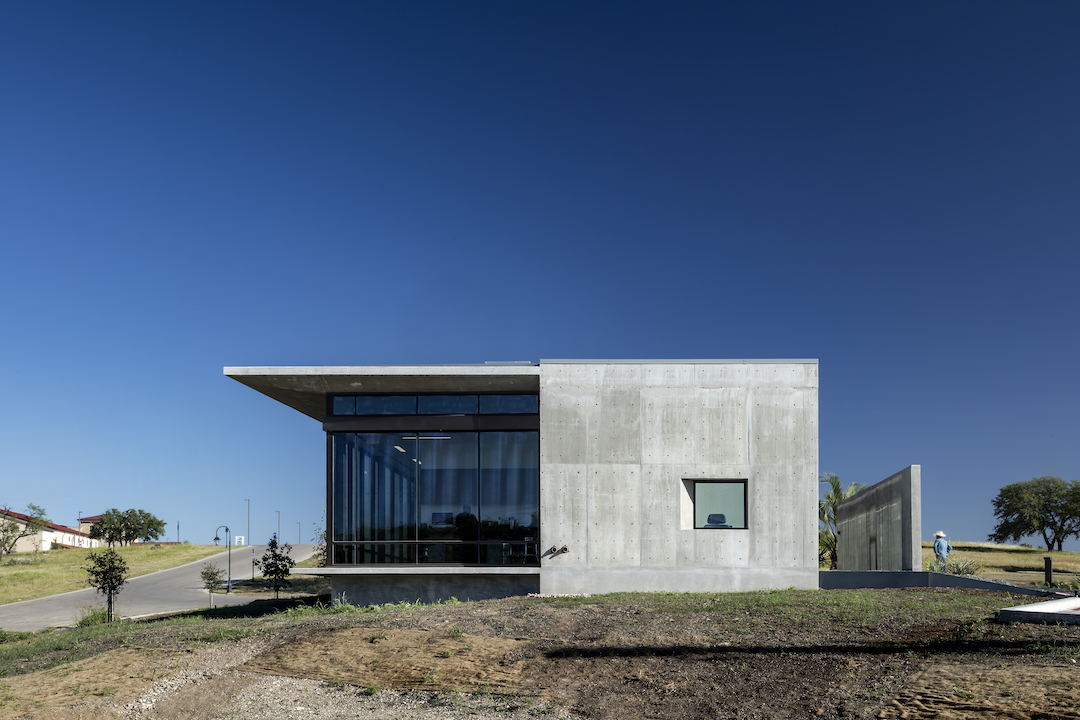 Photo: Charles Davis Smith, courtesy AIA
Photo: Charles Davis Smith, courtesy AIA
The Westlake Dermatology building stands out as a timeless frame in the rolling landscape, rather than appearing clinical or sterile. The medical and cosmetic dermatology practice was founded by Dr. Nikolaidis who believes great design serves as an inspiration for aesthetics. The facility in Marble Falls was a ground-up design project strengthened by a collaborative process directly with the clients and consultants. From a distance, the structure is a pavilion in the landscape, standing as a structure to behold in and of itself, but from in and round the building, it acts as deferential backdrop to function and as a frame for views beyond.
The nuanced concrete and glass shell merges with the designed landscape architecture, enveloping the bright and open interior in calm and quiet as one transitions from the road, through a garden zone, and into the space overlooking the rolling hills. Patient care and comfort are priorities – both influencing the design to embody feeling of security, ease, and solidity. Calibrated detail along with careful material selection result in a soothing and refreshing environment that is considerate of spatial and sensory experiences.
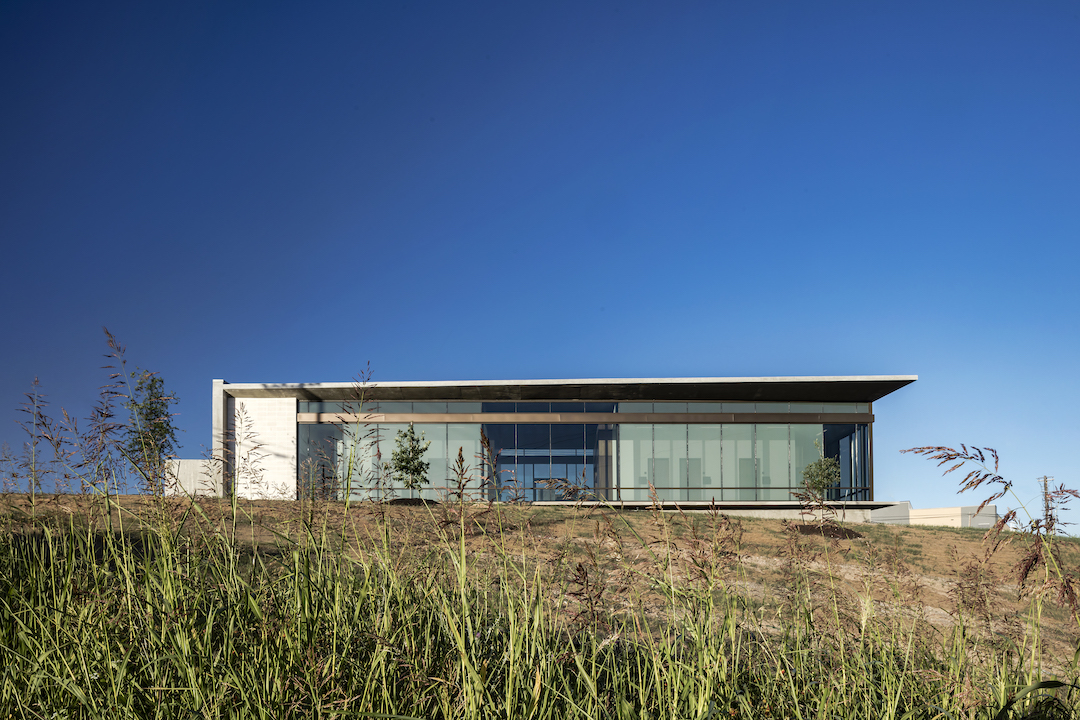 Photo: Charles Davis Smith, courtesy AIA
Photo: Charles Davis Smith, courtesy AIA
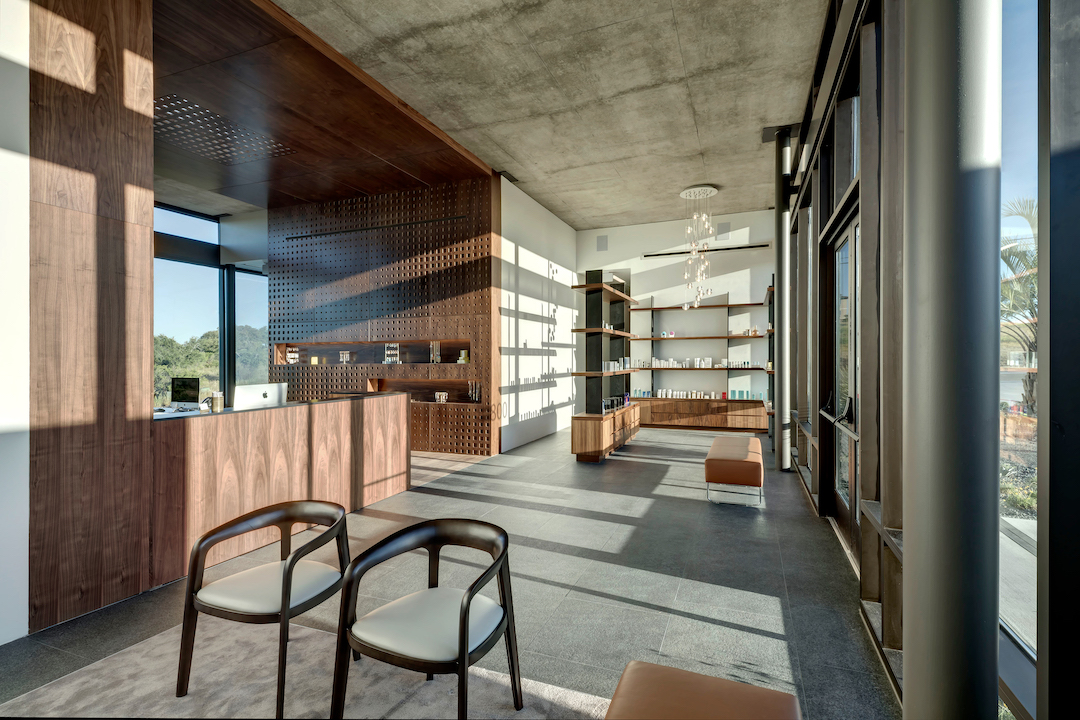 Photo: Charles Davis Smith, courtesy AIA
Photo: Charles Davis Smith, courtesy AIA
Project attributes
Construction cost or anticipated construction cost: $1.8 million
Building area or anticipated building area: 3,000 sq ft
Construction start date or anticipated construction start date: April 2016
Substantial completion date or anticipated substantial completion date: May 2017
Project team
Engineer - Civil: LJA Engineering
Engineer - MEP: DBR Engineering Consultants
Engineer - Structural: MJ Structures
Furniture Selection: Allison Burke Interior Design
General Contractor: Zapalac Reed
Landscape Architect: Eden Garden Design
Category B - Built: More than $25 million (construction cost)
Casey House, Toronto, Canada | Hariri Pontarini Architects
 Photo: Doublespace Photography, courtesy AIA
Photo: Doublespace Photography, courtesy AIA
The renovation and extension to Casey House, a specialized healthcare facility for individuals living with HIV/AIDS, develops a new prototype for hospitals. The facility meets the needs of patients in a setting designed to evoke the experience and comforts of home. In order to create a comfortable, home-like user experience, the embrace emerged as a unifying theme—one of warmth, intimacy, comfort, privacy, connectivity, and solidity. The architecture is a physical manifestation of the embrace. The extension reaches over and around the existing heritage designated building, which has been restored, while the new addition—a robust, textured exterior— surrounds the central courtyard. The landscaped courtyard is visible from every corridor and in-patient room and, given the private nature of the facility, provides protected outdoor space.
Once inside, the experience is about engagement of the old and new, and the organization—the embrace—around the courtyard, which is the ever-present symbol of life-affirming green, water, and light (trees, fountain, and sunlight). The living room, the central gathering space, featuring a two-story atrium, is anchored by a full-height fireplace crafted from Algonquin Limestone. A bridge connects the heritage and new spaces on the second floor with long views stretching from end to end.
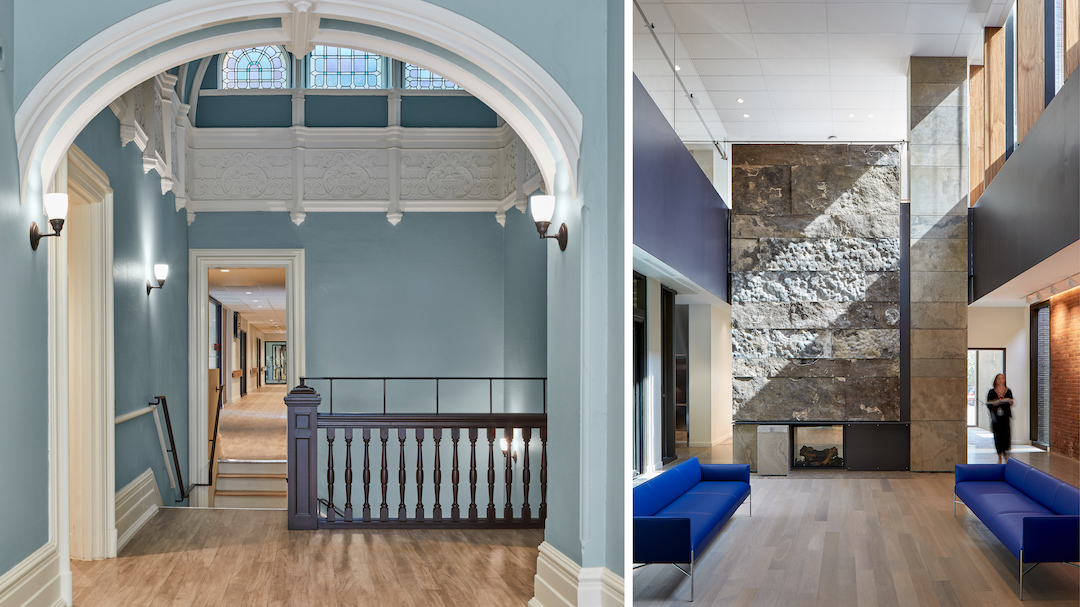 Photo: Doublespace Photography, courtesy AIA
Photo: Doublespace Photography, courtesy AIA
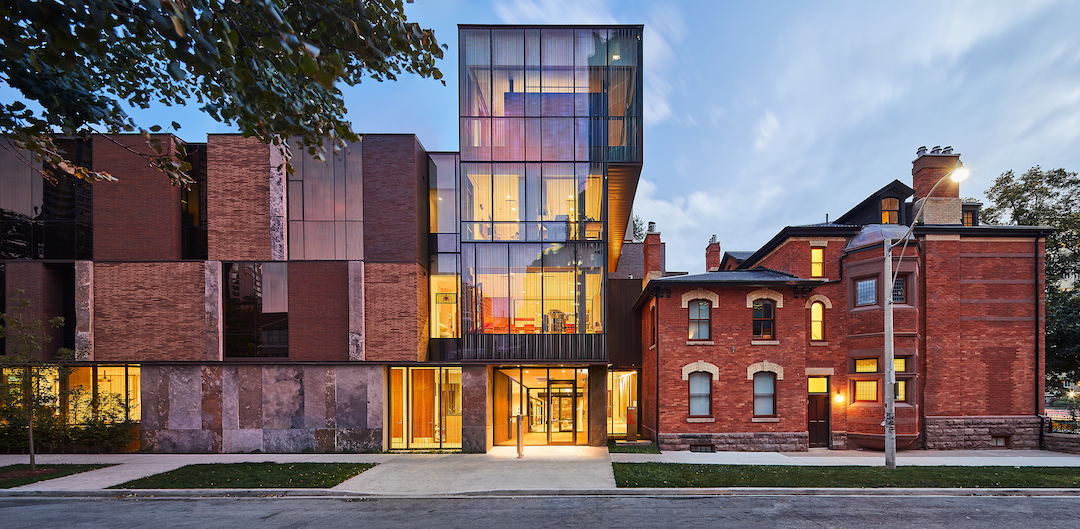 Photo: Doublespace Photography, courtesy AIA
Photo: Doublespace Photography, courtesy AIA
Project attributes
Construction cost or anticipated construction cost: $30 million
Building area or anticipated building area: 59,000 sq ft
Construction start date or anticipated construction start date: March 2015
Substantial completion date or anticipated substantial completion date: September 2017
Project team
Acoustics: Swallow
Code Consultant: David Hine Engineering
Engineer - ME: WSP Canada
Engineer - Structural: Entuitive
Food Service: Kaizen Foodservice Planning
Heritage Consultant: ERA Architects
Landscape Architect: Mark Hartley Landscape Architect
Security: Mulvey & Banani
The U.S. Department of Veterans Affairs Palo Alto (VAPA) Polytrauma and Blind Rehabilitation Center, Palo Alto, California | SmithGroup and The Design Partnership LLP
 Photo: Tim Griffith and Kyle Jeffers, courtesy AIA
Photo: Tim Griffith and Kyle Jeffers, courtesy AIA
The new VA Palo Alto (VAPA) Polytrauma and Blind Rehabilitation Center is one of only five polytrauma centers in the country designed specifically to serve and enhance the patient rehabilitation experience of polytrauma, blind and visually impaired veterans. At 174,000 square feet, it is not only the largest federal rehabilitation facility but also the only center to house polytrauma and blind rehabilitation services under one roof.
The Center’s impactful approach to healing through design—where the environment itself is a tool for rehabilitation—provided the design team provided the team with multiple opportunities to improve the patient experience by designing for our senses—touch, movement, smell, taste, sight, hearing and balance. The evaluation of each design element against these human sensory metrics resulted in a more immersive and healing space for patients, staff and visitors alike. The Polytrauma and Blind Rehabilitation Center exemplifies equity by design—minimizing barriers that patients face to maximize the potential for successful rehabilitation. The design integrates the latest advances in accessibility, universal design, and rehabilitation practices, resulting in a healthcare facility that aims to not only enhance patient recovery during their rehabilitation journey but long after.
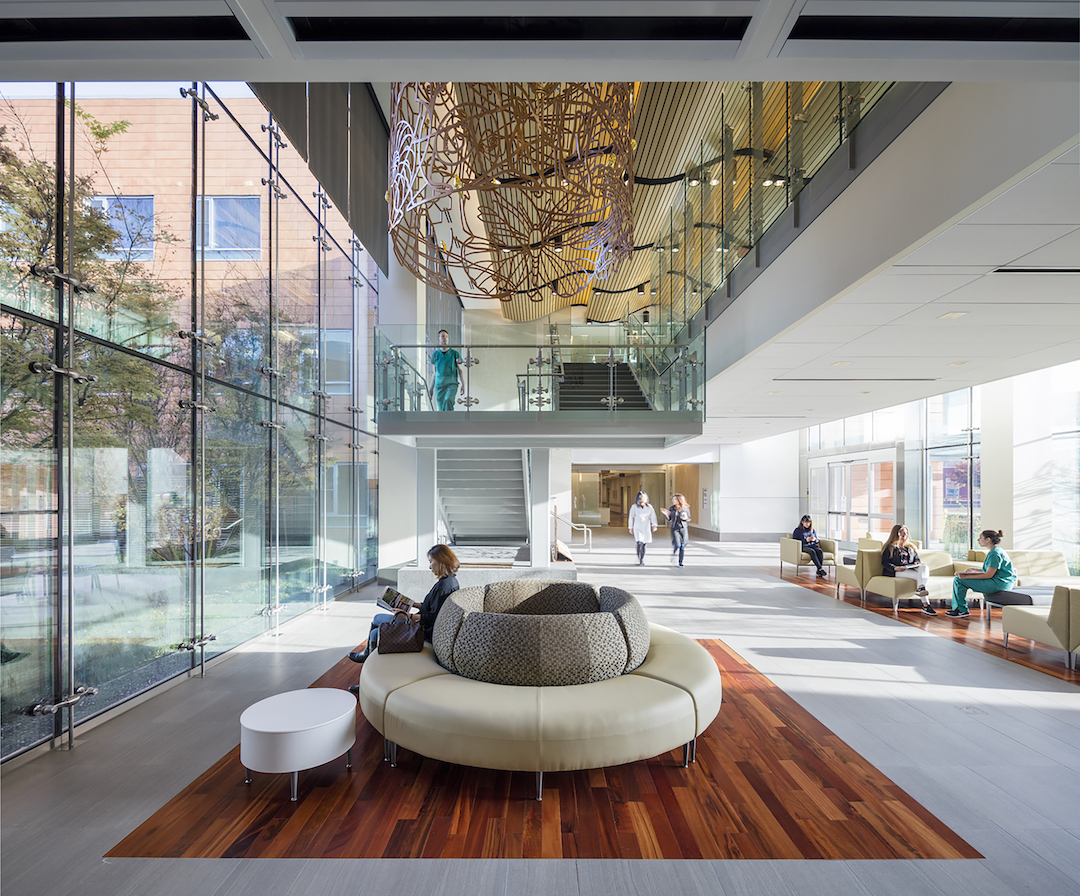 Photo: Tim Griffith and Kyle Jeffers, courtesy AIA
Photo: Tim Griffith and Kyle Jeffers, courtesy AIA
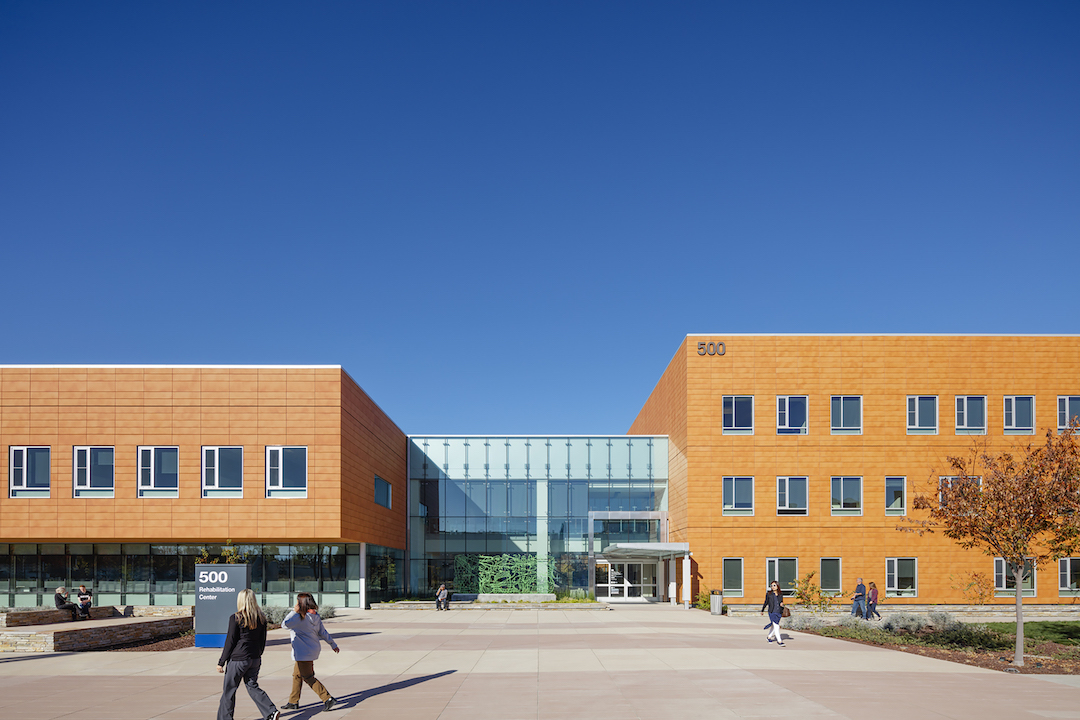 Photo: Tim Griffith and Kyle Jeffers, courtesy AIA
Photo: Tim Griffith and Kyle Jeffers, courtesy AIA
Project attributes
Construction cost or anticipated construction cost: $600 million
Building area or anticipated building area: 174,000 sq ft
Construction start date or anticipated construction start date: October 2011
Substantial completion date or anticipated substantial completion date: November 2020 (estimated)
Project team
Acoustics: Charles M. Salter Associates, Inc.
Engineer - Civil: BKF Engineers
Engineer - Electrical: Guttmann & Blaevoet | Cammisa + Wipf
Engineer - Mechanical : Capital Engineering Consultants, Inc.
Engineer - Plumbing: Capital Engineering Consultants, Inc.
Engineer - Structural: Degenkolb Engineers
Geotechnical: Treadwell & Rollo, a Langan Company
Interiors: SmithGroup
Landscape Architects: Keller Mitchell & Co. | Royston Hanamoto Alley & Abey
Planning: SmithGroup
Signage: Kate Keating Associates
Technology: TEECOM
Category C - Renovations/Remodeled: Primarily built within existing hospital or clinical space or adaptive reuse of an existing building to a healthcare use.
Studio Dental II, San Francisco | Montalba Architects
 Photo: Kevin Scott, courtesy AIA
Photo: Kevin Scott, courtesy AIA
Situated within a rapidly developing neighborhood in San Francisco’s financial district, the dentists’ brick and mortar location is defined by a modern aesthetic, while honoring the historic elements of the base building. This creates a transcendent environment that feels gallery-like and serene. The design centers on a conceptual ‘lantern’ within the dark building core, which communicates a sense of scale, luminescence, and transparency, and envelopes the series of operatories within. The lantern wall panels not only light up the dark building shell, but also glow through the storefront to brighten the street. The lantern provides patient privacy while engaging with the pedestrian street front, in an effort to energize the surrounding community.
In place of a common waiting room, a park-like bench extends the length of the space. Wood trellises provide separation between the bench and operatory rooms without closing off the space. Moments of material contrast are introduced between the rough shell walls, smoked mirror panels, and central colonnade of maple monoliths, which serve as functional storage and define the entry to each private patient room.
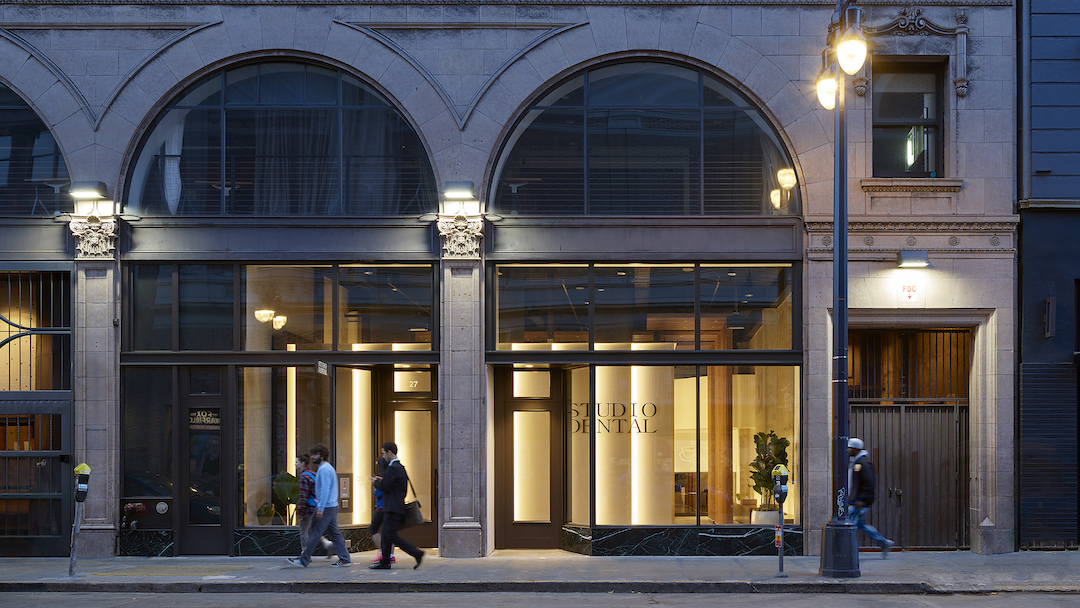 Photo: Kevin Scott, courtesy AIA
Photo: Kevin Scott, courtesy AIA
 Photo: Kevin Scott, courtesy AIA
Photo: Kevin Scott, courtesy AIA
Project attributes
Construction cost or anticipated construction cost: Withheld per Client's request
Building area or anticipated building area: 1,400 sq ft
Construction start date or anticipated construction start date: November 2016
Substantial completion date or anticipated substantial completion date: June 2017
Project team
Engineer - MEP: ACIES Engineering
Engineer - Structural: Julia Y. Chen Design Inc.
General Contractor: Build Group
Lighting: Sean O'Connor
Lighting Fabricator - Millwork: Pacific Westline, Inc.
READ MORE ABOUT THE 2019 Healthcare Design Awards
Related Stories
Giants 400 | Jan 15, 2024
Top 130 Hospital Facility Architecture Firms for 2023
HKS, HDR, Stantec, CannonDesign, and Page Southerland Page top BD+C's ranking of the nation's largest hospital facility architecture and architecture engineering (AE) firms for 2023, as reported in the 2023 Giants 400 Report.
Healthcare Facilities | Jan 7, 2024
Two new projects could be economic catalysts for a central New Jersey city
A Cancer Center and Innovation district are under construction and expected to start opening in 2025 in New Brunswick.
Designers | Jan 3, 2024
Designing better built environments for a neurodiverse world
For most of human history, design has mostly considered “typical users” who are fully able-bodied without clinical or emotional disabilities. The problem with this approach is that it offers a limited perspective on how space can positively or negatively influence someone based on their physical, mental, and sensory abilities.
Healthcare Facilities | Dec 19, 2023
A new hospital in Duluth, Minn., is now the region’s largest healthcare facility
In Duluth, Minn., the new St. Mary’s Medical Center, designed by EwingCole, is now the largest healthcare facility in the region. The hospital consolidates Essentia Health’s healthcare services under one roof. At about 1 million sf spanning two city blocks, St. Mary’s overlooks Lake Superior, providing views on almost every floor of the world’s largest freshwater lake.
Healthcare Facilities | Dec 7, 2023
New $650 million Baptist Health Care complex opens in Pensacola
Baptist Health Care’s new $650 million healthcare complex opened recently in Pensacola, Fla. Featuring a 10-story, 268-bed hospital, the project “represents the single-largest investment in the healthcare history of northwest Florida,” said Gresham Smith project executive Robert “Skip” Yauger, AIA, LEED AP. The 602,000 sf Baptist Hospital is equipped with a Level II trauma center that provides 61 exam rooms and three triage areas.
Engineers | Nov 27, 2023
Kimley-Horn eliminates the guesswork of electric vehicle charger site selection
Private businesses and governments can now choose their new electric vehicle (EV) charger locations with data-driven precision. Kimley-Horn, the national engineering, planning, and design consulting firm, today launched TREDLite EV, a cloud-based tool that helps organizations develop and optimize their EV charger deployment strategies based on the organization’s unique priorities.
Healthcare Facilities | Nov 3, 2023
The University of Chicago Medicine is building its city’s first freestanding cancer center with inpatient and outpatient services
The University of Chicago Medicine (UChicago Medicine) is building Chicago’s first freestanding cancer center with inpatient and outpatient services. Aiming to bridge longstanding health disparities on Chicago’s South Side, the $815 million project will consolidate care and about 200 team members currently spread across at least five buildings. The new facility, which broke ground in September, is expected to open to patients in spring 2027.
Sponsored | | Oct 17, 2023
The Evolution of Medical Facility Security
As the healthcare system grows, securing these facilities becomes ever more challenging. Increasingly, medical providers have multiple facilities within their networks, making traditional keying systems and credentialing impractical.
Healthcare Facilities | Oct 11, 2023
Leveraging land and light to enhance patient care
GBBN interior designer Kristin Greeley shares insights from the firm's latest project: a cancer center in Santa Fe, N.M.
Healthcare Facilities | Oct 9, 2023
Design solutions for mental health as a secondary diagnosis
Rachel Vedder, RA, LEED AP, Senior Architect, Design Collaborative, shares two design solutions for hospitals treating behavioral health patients.







